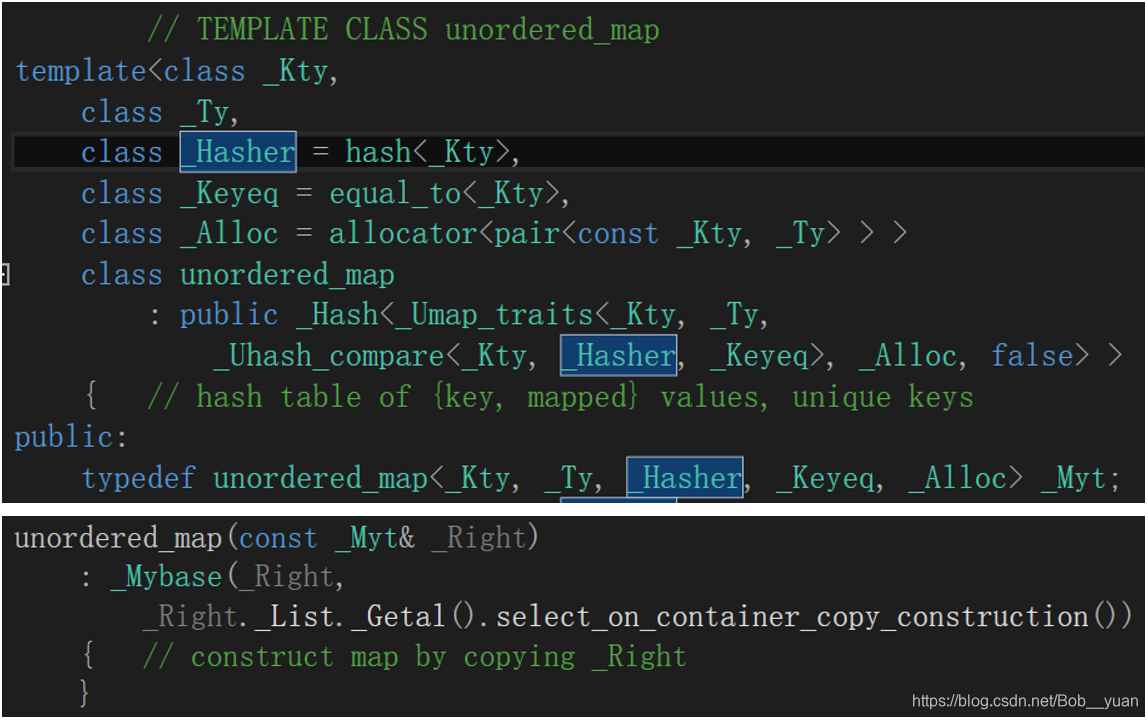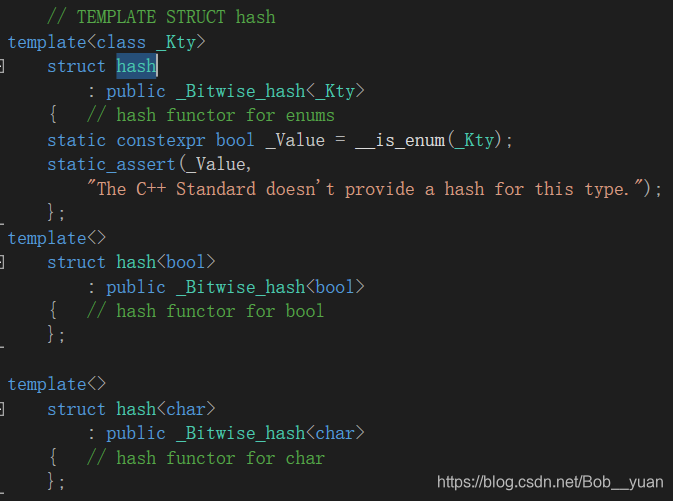unordered_map 是 C++ 11 中新加入的容器,和没有标准化的 hash_map 一个意思,使用 hash 表作为底层数据结构,那么对于键值就需要有 hash function 计算出对应的 hash 值了。
对于内置函数,hash function 是自带的,不需要显示指定,如下所示,使用 int、string 作为键值是可以的,但是使用 vector 和 pair 是不行,提示就是 'The C++ Standard doesn’t provide a hash for this type."。
#include <unordered_map>
#include <vector>
using namespace std;
int main() {
unordered_map<int, int> mmp;
unordered_map<string, int> mmp1;
// The C++ Standard doesn't provide a hash for this type.
unordered_map<pair<int, int>, int> mmp2; // Error
unordered_map<vector<int>, int> mmp2; // Error
}
那么这个 hsah function 是在哪里呢,跳到 unordered_map 定义的地方,可以看到,构造函数有很多中,unordered_map<string, int> mmp1; 这种形式进行构造的话,应该是下图这样的方式,也就是第一个模板参数是键值,第二个末班参数是值,第三个模板参数是hash function(hash<_Kty>),第四个模板参数是相等的比较函数(或者说表现为函数的对象),最后一个是分配器。

官方的五个参数的注释如下:
template < class Key, // unordered_map::key_type
class T, // unordered_map::mapped_type
class Hash = hash<Key>, // unordered_map::hasher
class Pred = equal_to<Key>, // unordered_map::key_equal
class Alloc = allocator< pair<const Key,T> > // unordered_map::allocator_type
>
class unordered_map;
我们可以通过 unordered_map<int, int>::hasher hs = mmp.hash_function(); 的方式得到 unordered_map 对于不同的键值计算出的 hash 值,也可以直接利用 hash()(1) 的方式进行调用,如下所示:
int main() {
unordered_map<int, int> mmp;
unordered_map<int, int>::hasher hs = mmp.hash_function();
cout << hs(1) << endl; // 4218009092
cout << hs(2) << endl; // 3958272823
cout << hash<int>()(1) << endl; // 4218009092, equal = hs(1)
cout << hash<string>()("abc") << endl; // 440920331
cout << hash<float>()(3.1415926) << endl; // 812821127
cout << hash<double>()(3.1415926) << endl; // 2306040251
}
我们可以调到 hash 这个结构的定义部分,如下图,对于基础类型,都给出了对应的模板特化,也可以看到上边编译错误时报错的地方。

所以如果对于自定义类型,或者 hash 这个结构没有提供模板特化的数据类型,那就需要自己定义了,最简单的方法就是:
struct pair_hash {
template<class T1, class T2>
std::size_t operator() (const std::pair<T1, T2>& p) const {
auto h1 = std::hash<T1>{}(p.first);
auto h2 = std::hash<T2>{}(p.second);
return h1 ^ h2;
}
};
int main() {
//unordered_map<pair<int, int>, int> error_mmp; // error
unordered_map<pair<int, int>, int, pair_hash> ok_mmp; // ok
}
unordered_set 同理,都是用的哈希表。
























 1336
1336

 被折叠的 条评论
为什么被折叠?
被折叠的 条评论
为什么被折叠?








